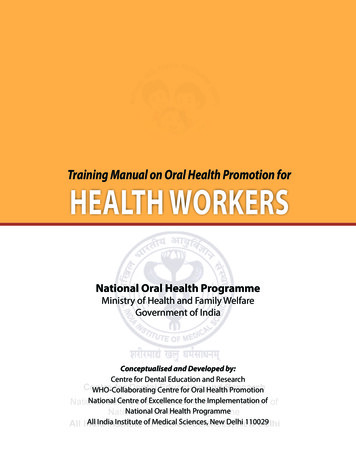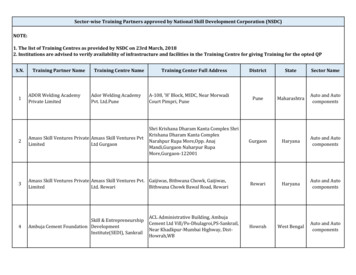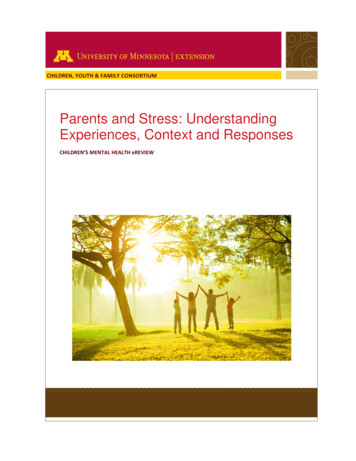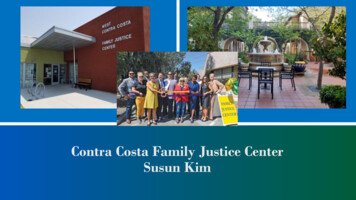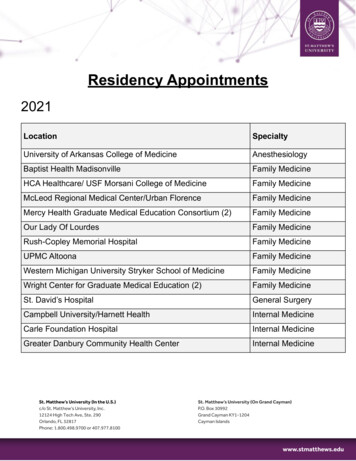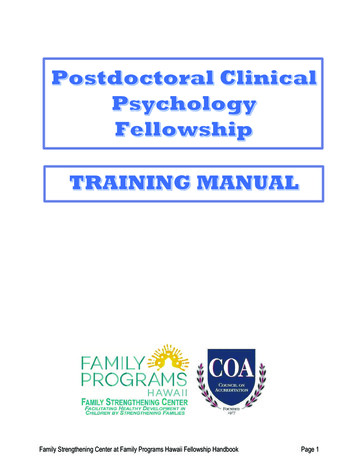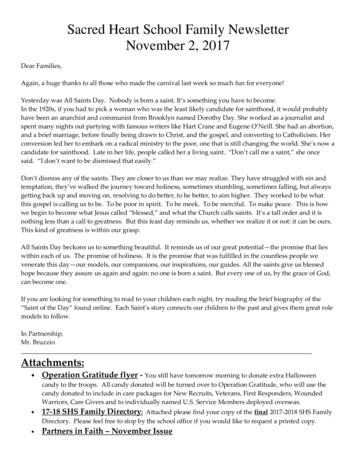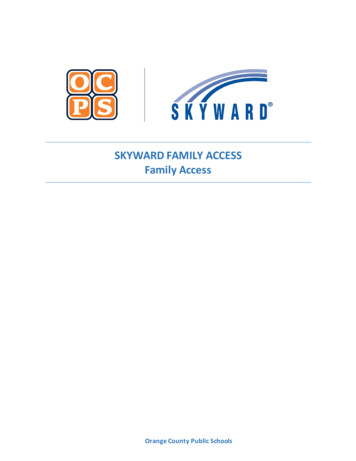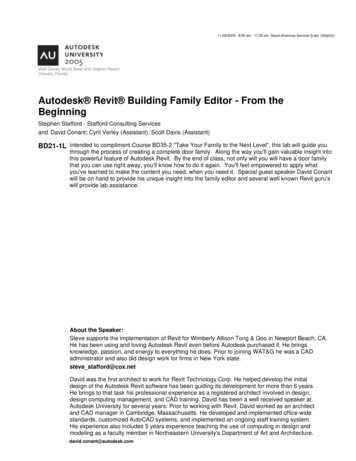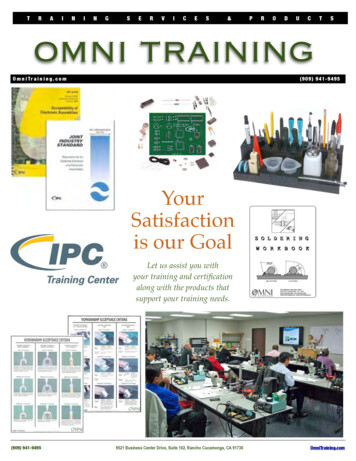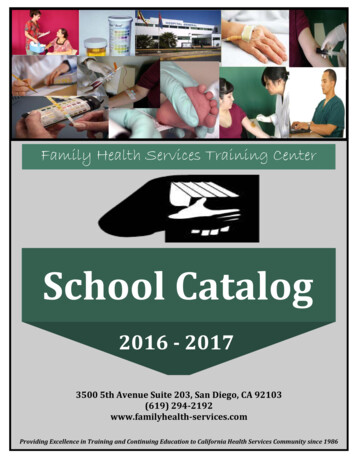
Transcription
Family Health Services Training CenterSchool Catalog2016 - 20173500 5th Avenue Suite 203, San Diego, CA 92103(619) 294-2192www.familyhealth-services.comProviding Excellence in Training and Continuing Education to California Health Services Community since 1986
A message from the presidentO. Lawrence Stitt, MPHPresident, CEOFamily Health Services Training Center, INC.WelcomeThe Family Health Services Training Center was established in1986 in the state of California,County of San Diego. The center is a private institution that offers postsecondary training toindividuals preparing for careers in allied health professions and continuing education topracticing health care professionals.The training center is in full compliance with the California Education Code.Training programs and courses are recognized and approved by a myriad of local state andnational licensing boards and professional associations. All instructors hold advanceddegrees and professional licenses and each brings years of experience in their fields of expertise.Thank you for your interestO. Lawrence Stitt CLS, MPHPresident and CEO2
Table of ContentsPages1. General Information42. Facilities53. Faculty and Staff104. Admission Policies and Procedures145. Student’s Right to Cancel and Refund Policy226. Cost of Training237. Student Tuition Recovery Fund (STRF)248. The Phlebotomy Program26-Instructional Goals and Objectives32-Equipment35-Requirements for Eligibility43-Application Requirements49-Course Schedule51-Clinical Internship52-Foreign Educational Credential Translation Services58-Phlebotomy Syllabus – Schedule of Practical Training62-Patient’s Bill of Rights679. Enrollment Agreement-School Performance Fact Sheet70783
General InformationThe Family Health Services Training Center hereafter referred to as “the Center” is a privateinstitution that is approved to operate by the California Bureau for Private PostsecondaryEducation. Approval means this institution is in compliance with the California PrivatePostsecondary Act of 2009. Neither the Center nor any of its training programs are accreditedby an accreditation agency recognized by the US department of education.As a prospective student, you are encouraged to review this catalog prior to signing anenrollment agreement. You are also encouraged to review the School Performance Fact Sheet,which must be provided to you prior to signing an enrollment agreement.Any questions a student may have regarding this catalog that have not been satisfactorilyanswered by the institution may be directed to the Bureau for Private Postsecondary Educationat 2535 Capitol Oaks Drive, Suite 400, Sacramento, CA 95833, www.bppe.ca.gov, toll-freetelephone number (888) 370-7589 or by fax (916) 263-1897.The catalog is updated annually. This catalog covers the time period beginning January 1, 2016– December 31, 2017 and is available to perspective students’ onsite in the school office duringall hours of operation at no cost.A copy of the catalog will be mailed to students upon request at no cost. Students as well asgeneral public may print out a copy of the catalog when visiting the Family Health Serviceswebsite at: www.familyhealth-services.com or contact us at (800) 294-2192.A student or any member of the public may file a complaint about this institution with theBureau for Private Postsecondary Education by calling (888) 370-7589 toll-free or by completinga complaint form, which can be obtained on the bureau’s internet web site www.bppe.ca.gov.All instruction for courses offered by the Family Health Services Training Center are held onsiteat 3500 5th Avenue, #203, San Diego, CA 92103.The Center was founded in 1986 with the stated mission of providing continuous excellence ineducation and training to practicing members of the healthcare profession as well as providingbasic training and certification that could serve as a portal of entry to individuals seeking acareer in the healthcare profession. This mission is realized through the center’s phlebotomytraining program.The goal of the phlebotomy training program is to upgrade the knowledge and skills ofcurrently employed healthcare professionals in the performance of blood withdrawal and topique the awareness of these professionals to the most recent trends in blood analysis andclinical laboratory medicine. The phlebotomy training course is designed to provide studentswith the skills and knowledge necessary to work in variety of medical settings including: ClinicalLaboratory, Hospitals, Clinics, Physician’s Offices, Blood Bank and much more.4
FacilitiesThe Family Health Services Training Center has sufficient facilities and equipment to supportthe achievement objectives of all the courses and educational programs in which students areenrolled. The Centers facilities including heating and cooling, ventilation, lighting, classrooms,laboratories, and campus environs, are well-maintained.The Center maintains all valid permits required by any public agencies relating to the health andsafety of the institution’s facilities and equipment on file. These permits are available uponrequest.Physical FacilitiesThe FacilityThe Family Health Services Training Center currently occupies a physical space of 8000 sq. ft.located at 3500 5th Ave. in San Diego, CA 92103. Approximately 75% of this space or 600 sq. ft.is dedicated to the institution’s training programs.5
Practical LaboratoryThese facilities include classrooms adequate to seat program students and a training laboratorydedicated to the phlebotomy program. There are both male and female toilets dedicated to thisarea. Each are equipped with handicap and other safety features. There are four (4) handwashing sinks dedicated to this area and are used for sanitation and demonstrations.6
School OfficeA space of approximately 200 sq. ft. is located on the upper level and is dedicated toadministrative offices, conference room and secured file cabinets.The two spaces are connected by an elevator. The municipal permit for safety of the elevator isposted. There is accessible parking including handicap spaces. There is access to the facilitiesfor the disabled. The facility is permitted by the local health authority to be safe for publicoccupancy.7
Physical Resources-Information ResourcesThe Family Health Services Training Center ensures that each student admitted to the programshave access to information resources including current editions of books, periodicals and otherreference materials in contemporary formats related to all content areas of the curriculum.On the first day of class each student is provided with the course books for Basic Phlebotomy101, Advance Phlebotomy 202 and the manual of practical phlebotomy. These are fairlycomprehensive texts over 400 pages each of research and complied by members of thephlebotomy staff. The cost of these texts is included in the course cost.In addition to the educational materials described above the following publications arerecommended. At least two (2) powerpoint presentations are based on one or more of thesepublications.1. McCall and Tankersley Phlebotomy Essentials 4th edPub. Lippincott Williams and Williams 20042. Garza and McBride Phlebotomy Handbook 6th ed.Prentice Hall Pub. 2002 Pearson Education INCThere currently are no library facilities provided by the training center. However, students haveaccess to the main municipal library located only blocks away and to its many satellitebranches. Students are not required to obtain a library card. However, the city library cardapplication form is available in the registrar office. Students may opt to complete and returnthis form to the library to obtain a library card at no charge. Below are the location, days andhours of the public library. This information is made available to each student.330 Park Blvd. San Diego, CA 92101Hours of 8
Adequate instructional resources are available to facilitate each student’s attainment ofexcepted competencies in the Center’s programs.The most important physical resources used in the phlebotomy course which allows eachstudent to attain competency are artificial body parts, including artificial arms and handscomplete with artificial blood. Each student is assigned the necessary artificial body partincluding arms, hands and fingers and under close supervision is able to begin the process ofdeveloping skill and techniques that lead to competency.Physical resources-computer technologyEach student in the phlebotomy program is provided access to and experience withcontemporary computer technology.Nearly all students admitted to the phlebotomy course arrive with basic computer skills and abasic understanding of computer technology students are provided didactic instruction relatedto computerized communication onsite at the training center and provide the experience usingcontemporary computer technology during clinical experience. During didactic instructionheavy emphasis is placed on the critical role of computerized communication between theclinical laboratory and everyone else in the healthcare environment and the role ofphlebotomist in carrying out such functions as:1.2.3.4.5.Entering test requisitionsGenerating patient and specimen labelsIdentifying specific test to be analyzedReporting and storing test resultsForwarding test results to healthcare providersIn the clinical setting students are provided access to computer technology while performingthe functions listed above. It is the responsibility of the phlebotomy program director to ensurethat all activities engaged in by students in the clinical setting contributes to student education.Assurance that students will have access to computerized technology is a priority.9
Faculty and StaffOperation Manager1. Reports to chief executive officer2. Serves as office manager3. Delegate responsibilities for human resources tasks:a. Monitors employee absenteeismb. Manages fringe benefits including vacation, sick leave and vacation daysc. Identifies personnel problems that may affect the centers operationd. Participate with the chief executive officer in resolving such issues4. Manages accounts receivable5. Monitors student payments6. Monitors students and third party payers7. Manages payroll and federal and state tax obligations8. Provides oversight for tasks performed by the Administrative AssistantsAdministrative Assistant IIDuties include but are not limited to the following:1. Reports to the chief executive officer2. Performs tasks as delegated by CEO3. Responsible for managing and co-coordinating the phlebotomy training program4. Schedules onsite phlebotomy training classes5. Schedules all phlebotomy related in-house training6. Conducts orientation sessions at the beginning of each phlebotomy class7. Organizes student academic and financial files and provide security for same8. Prepares and package documents required for State licensure9. Monitors students attendance and progress reports10. Appropriate student problems and or concerns to the chief executive office11. Participates in the resolutions of problems, concerns, monitors and records studentpayment of fees12. Interfaces with contracted affiliates i.e. hospitals, clinics etc to place students forinternship13. Works closely with the centers academic advisor in student placements14. Interviews applicants to the phlebotomy course as part of student assessment10
InstructorsAll instructors are contracted by the Center to provide instruction in their areas of expertisemost hold advanced degrees and all are experienced and certified and are considered to besubject matter experts.Phlebotomy InstructorPhlebotomy classes are presented in English only. Instructors are required to be approved bythe California Department of Health Services and are required to adhere to the Center’s Stateapproved curriculum and guidelines when preparing lesson plans. Lectures are presented infour (4) hour periods during mornings, afternoons, evenings and weekends. Laboratory sessionsfollow theory and are of the same duration.11
Faculty Members and QualificationsThe Phlebotomy ProgramSean StittInstructor, Phlebotomy, California Department of Public Health,EducationCertificationM.S. Marriage, Family and Child TherapyMedical Laboratory Technician(MFT) – University of PhoenixCertified phlebotomy technician, CaliforniaBS psychology – San Diego State UniversityDepartment of Health,Certified foodsafety instructor San DiegoExperienceDepartment of Environmental Health19 yearsRoger CasillanPhlebotomy InstructorEducationBS – St. Louis University of PhilippinesExperience22 yearsCertificationMedical Laboratory TechnicianCertified Phlebotomy Technician, CaliforniaDepartment of HealthTerry JordanPhlebotomy Practical InstructorEducationMPH – National UniversityBS – Embry UniversityCertificationCertified Phlebotomy Technician, CaliforniaDepartment of Public HealthExperience6 years12
Organization and ManagementOrganization ChartPresident, CEOOtis L. StittOperations ManagerMaricar CendanaAdministrative Assistant IITerry JordanPhlebotomyInstructorSean Stitt, CPT1PhlebotomyInstructorRoger Casillan, CPT1Phlebotomy PracticalInstructorTerry Jordan, CPT113
Admission Policies and ProceduresThe Family Health Services Training Center has written admission standards for each of itseducational programs. These standards are related to the specific program and ensures that nostudent will be admitted who is obviously unqualified.According to California Code of Regulation, where applicable, each student admitted to anundergraduate or degree program must possess a high school diploma or its equivalent.This standard applies to the phlebotomy program which is fairly comprehensive and leads to adiploma. In the state of California, admission standards for phlebotomy training are set forth inthe state’s phlebotomy law (see a detailed graphic of the California phlebotomy law on page43, a more detailed description of the requirements is followed on page 44-50).Admission requirements for phlebotomy offered by the Center are largely defined by state ofCalifornia department of public health (CDPH).Phlebotomy Technician Certification Course Admission Requirements:1.2.3.4.5.6.EducationPreparationPrior TrainingName of ProgramMethod of InstructionGraduation Requirement- High school diploma/GED equivalent- None- None- Phlebotomy Technician I- Include classroom instructor led- Successful completion of course exam(satisfactory performance of the internshipexperience)7. Background Check-Required8. The phlebotomy technician program is designed to prepare the student for statecertification in phlebotomy and an entry level position in healthcare.All instruction in the phlebotomy course is available in English only. The target population forthis program is California Residents that are fluent in English.Competency in English language is a requirement for admission to the phlebotomy program.The vast majority of students accepted into the program are graduates of English speaking highschools and on this basis is assessed to be competent in the English language.Students who speak English as a second language (ESL) and who have graduated from a nonEnglish speaking high school are required to successfully pass the Test of English as a ForeignLangauge (TOEFL). Contact information pertaining to TOEFL is made available such ESL studentsat the time of registration (https://www.ets.org/toefl).14
AttendanceStudents are expected to attend all classes of the course. Students with up to 2 excusedabsences will be issued a verbal warning along with a makeup schedule for the classes missed.Students that accrue three or more absences are excluded from the current course but may bere-instated to a subsequent class. Students will be accredited hours completed from theprevious class. No additional fees will be required.-An excused absence is defined as an absence for a valid reason that was pre-approvedby the school office, or absence due to illness provided student presents a doctor’s noteStudents are required to call and inform the school office for any foreseen absences ortardinessMake-ups for excused absences are to be arranged with the instructorTardiness and early departures from classes accrue and have a cumulative effect onabsenteeismStudents are expected to report on time. A grace period of fifteen minutes shall be applied.Students will be allowed to have a break time of 10-15 minutes at the midpoint of their traininghours.Leave of AbsenceThe Center understands that life events may require the students to modify class enrollmentand schedules. A student may request a leave of absence up to a maximum of 30 days. Uponreturn, the student may be re-instated to a subsequent course that begins on the first Friday ofthat month. It is the responsibility of the student to inform the center of the source financialaid if any, and to discuss any consequences that might occur as a result of leave. Students areencouraged to submit a leave request sooner rather than later. A request for a leave of absenceis submitted in writing to the Operations Manager. The request must contain the reason for theleave of absence and the amount of time requested. Notification of approval or denial isreturned to the student in writing within 48 hours. Unexcused leave in excess of fourconsecutive classes may be taken as abandonment of the course.Student RecordsCalifornia State Department of Public Health (CDPH) requires all students enrolled in the stateapproved phlebotomy program to forward original copies of certain documents to that agencybefore state certification can be issued including educational transcripts, documents showingpassing scores on exams and personal information including photographs. Family HealthServices Training Center maintains student files that include copies of all the above records inaddition to certain academic financial records as outlined below.The Family Health Services Training Center maintains a file on each student enrolled in thephlebotomy program.15
1. Written records and transcripts of formal education training and experience which maybe applicable to admission to the phlebotomy program are maintained in a file. Theserecords include:a. High school transcript or GED documentb. Diplomas and or certificates documenting training from other institutionsc. Grades or scores from national certifying agenciesd. All applicable documents including those providing proof of prior clinicalexperiential2. Students in the phlebotomy course required by state phlebotomy law to provide aphotograph as a prerequisite to state certification. A duplicate of this document is keptin the student file. However, other personal information regarding student’s age,gender, and ethnicity may also be a part of the record only if this information has beenvoluntarily submitted by the student.3. Copies of all documents signed by the student including the enrollment agreement,document relating to financial aid and all other records relating to payment of fees andtuition are filed.4. Records of the date of enrollment, attendance records, leave of absence, withdrawalfrom the program and graduation documents are maintained. The institution shallmaintain all pertinent student records including the above documents described in item2-4 for a period of five years from the student date of completion or withdrawal.5. Phlebotomy program require transcripts from other institutions.-While students enrolled in the phlebotomy program may not receive academiccredit they can be awarded credit for prior clinical experience. Documentation ofsuch experience is kept in the student file.There is no provision in phlebotomy program to award credit for courses earned atanother institution.There is no provision in phlebotomy program to award credit based on any examinationfor admission to these programs.The document showing experimental clinical training contains the name, address, webaddress and telephone number of the institution providing the training is a part of thestudent file.6. There are no provisions for independent study courses in the phlebotomy program.7. Students enrolled in the center’s programs are not assigned projects such asdissertations or theses.16
8. Copies of all documents relating to student financial aid are filed in the student recordas required by federal law.9. A statement showing the total amount of money received from or on behalf of thestudent showing the dates the money was received is filed in the student file.10. A document specifying the amount of refund, including the amount refund for tuitionand the amount for other itemized charges, the method of calculating the refund, thedate the refund was made and the name and address of the person or entity to whichthe refund was sent is filed in the student record.11. All copies of official notices or warning regarding student progress are filed in thestudent record.12. All complaints received from the student are filed in the student record.The Family Health Services Training Center maintains all student records that are required to bemaintained by the California Private and Postsecondary Act. All such records are maintained inthe state of California.Student records are stored by (1) hard copy, (2) electronically and (3) a combination of both. Inall cases records are stored in a secure location without loss of information or legibility.Current records include those which are filed within a period of three (3) years. These recordsmay be immediately reproduced electronically, by computer or hard copies filed here at thetraining center. Exact legible copies of records maintained for longer than three (3) years maybe reproduced within two (2) business days. All student records are maintained for a period of5 years. Education transcripts are maintained permanently.The administrative assistant to the to the operations manager who is on duty during normalbusiness hours has access to and is familiar with the computers that contain student files aswell as secured files containing hard copies of student records. This individual is tasked with theduty to retrieve files and is able to discuss the retrieval process with any person authorized toinspect and/or copy records. The administrative assistant under the direction of the operationsmanager may give immediate access to any authorized person to computer and/or filescontaining student records.Bar from AttendanceStudents may be barred from attendance for failure to:1. Comply with the Center’s policies2. Respond to official notices3. Settle financial obligations when due17
VisitorsNo one may visit a classroom during class hours without permission from the Center’s office.Students are not allowed to bring children to the classroom or laboratories while attendingclass.InternshipEach student is offered a clinical internship at an affiliated medical facility. The Center willdesignate, in writing, a faculty supervisor who will coordinate with a designee of the facilitycoordinator. The faculty supervisor and the facility coordinator together shall coordinate theclinical or practicum scheduled of each student participating in this clinical educationexperience.Failure to Begin InternshipThe clinical internship is offered within 30 days of classroom instruction. Students who fail tobegin the internship after 60 days of classroom instructions may be required to repeat theclassroom practical sessions of the course and offered a second internship at no charge.Students who have not began the internship after 120 days from the completion of the coursefor whatever reason will be required to re-apply and repeat the entire course.Non Discrimination PolicyThe Center prohibits discrimination or harassment on the basis of race, ethnic group, andnational origin, religion, age, gender, sexual orientation, color, physical or mental disability,marital or veteran status.Smoking, Drugs and Alcohol PolicyThe Center prohibits smoking in the facility as well as outside stairways. Sale of tobaccoproducts at the Center’s facility is also prohibited. The Center supports the “Drug-Free-Schoolsand Communities Act Amendments of 1989” thus, the center prohibits the use of distribution ofillicit drugs and alcohol by students and employees.Student DisciplineStudents are expected to conduct themselves in a responsible manner that reflects ethics,honor and good citizenship. They are also expected to be aware of the Center’s expressedpolicies and to abide by them. Any form of inappropriate behavior by students or applicantsmay result in penalties including warning of dismissal as deemed appropriate by the Center.Probation, Suspension and DismissalStudents suspected of committing any violations of the Center’s policies are accordedprocedures consisting with fair process before disciplinary action is imposed including a18
hearing. The hearing committee is comprised of three individuals including the President orCEO who appoints a faculty member and a ranking member of the staff. The CEO identifies thelocation, date and time of the hearing and advises parties to the hearing. The CEO isresponsible for rendering the committees decision and the student’s right to appeal. Studentswho believe that they have been wrongfully or excessively penalized may appeal the decision.An appeal must be requested in writing within 30 days of notification.Grievance ProceduresThe Center encourages prompt reporting of complaints so that a rapid response can be madeand appropriate action taken. Note that reporting a complaint need not be limited to someonewho was a target of the discrimination or harassment. Any student who feels that they havebeen subjected to mistreat by a student or by the Center through any of its employees,contractors, entities, policies, procedures, or programs may file a complaint with the office ofVice President for Student Services.The Center will endeavor to maintain confidentiality of all complaints. The Center will attemptto strike a balance between the complainant’s desire for privacy and confidentiality and theCenter’s responsibility to provide an environment free of discrimination. The Center has a dutyto review the compliant even if the student declines to file.Students who believe that they have been subject of mistreatment of any kind including sexualharassment and unlawful discrimination may use the following informal procedures to resolvetheir complaint.Students have the right to file a formal written complaint if they believe informal resolution isnot possible. Students may, at any time, elect to stop these informal procedures.The office of Vice President will provide any student with an opportunity to discuss specificconcerns in a confidential setting.The Center encourages discussion between the parties directly involved in a dispute, especiallyin the early stages before the parties have assumed official or public positions that may polarizethe dispute and make resolution more difficult. Students may seek advice about how best toapproach the office of Vice President or to obtain other assistance, such as mediation.If no resolution is made the student may file a written complaint.Procedure for filing a Written Complaint:1) The complainant must file a claim by following the guidelines in this section. Formscan be obtained from the office of Vice President. The claim must be filed within 120days of the alleged mistreatment. The Vice President dates and logs all writtencomplaints and notifies in writing to the complainant that the complaint is underreview.19
2) If the complainant does not meet the procedural requirements, the Vice Presidentimmediately notifies the complainant of the specific deficiencies of the complaint. Ifthe complaint meets the procedural requirements, the Vice President forwards acopy of the complaint to the alleged offender or unit against which the complaint ismade.3) The Vice President will arrange appropriate interim measures when warranted toprotect the parties.4) The Vice President will investigate the complaint including meeting separately withthe student and with others who are either named in the complaint or who mayhave knowledge of the facts. Generally, the investigation is completed within thirty(30) days from the day of receipt.On completion of the investigation, the Vice President will prepare a report of the witnessstatements and the evidence. All relevant parties will be notified accordingly. The final report isgiven to the Chief Executive Officer within 10 days of receiving the report. The CEO will appointa hearing committee consisting of four individuals including the CEO, Vice President, member ofthe faculty and a ranking member of the staff.The CEO identifies the location, date and time of the hearing and advises parties to the hearing.The CEO is responsible for rendering the committees decision which is provided to each party inwriting within 10 days. An appeal must be requested in writing within 15 days. Either party mayfile a written appeal if they are not satisfied with the findings.Academic PoliciesAcademic ProbationStudents who fail to meet the minimum academic requirements as described in the gradingstandards are not allowed to continue in the program (please see standard of achievement onpage 28).The students’ academic process is closely followed throughout the course. Each student’sprogress is evaluated periodically. Students’ who are performing at or below grade “C” arerequired to attend academic conference with the instructor. Instructors will discuss thestudent’s academic situation and may recommend remedial study. The student is informed oftheir academic probation status and the possibility of being dismissed from the program unlessimprovement is evidenced.Academic Grievance Procedures and Appellate ProcessAppropriate faculty members at the Center have
3. Responsible for managing and co-coordinating the phlebotomy training program 4. Schedules onsite phlebotomy training classes 5. Schedules all phlebotomy related in-house training 6. Conducts orientation sessions at the beginning of each phlebotomy class 7. Organizes student academic and financial files and provide security for same 8.

